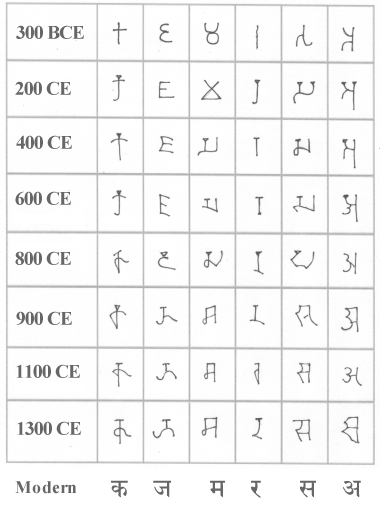Development of the Devanagari script.
The Devanagari script, used for writing Sanskrit and other Indian languages had evolved over a period of more than two thousand years. The true origin of writing in India has not been ascertained with any certainty though scholars believe that the starting point was the Brahmi script used in the inscriptions of emperor Asoka (300 BCE). It is however known that reference to writing is seen in the ancient scriptures of India, which have also defied proper dating.Under the circumstances, it is pointless to discuss the origin of writing in India. We therefore provide the development of the script based on records available in India in various forms.
The Brahmi script confirms to the syllabic writing system and was used more for writing Prakrit, the language spoken by ordinary people. All the aksharas (vowels and consonants) of Sanskrit find a representation in Brahmi along with forms for medial vowels. The inscriptions of Asoka, seen in many places in India,though spread over several centuries, are all in Brahmi, suggesting that the script had been evolving. When new additions to existing structures were built (such as the Stupas and special Pillars), it was usual practice to record the names of the donors.
The Brahmi script underwent changes and noticeable differences (compared to the Brahmi of 300 BCE) and the writing became more ornamental with curves. The Brahmi of 200 CE shows these differences clearly. Yet, the set of aksharas remained the same, catering to the basic vowels and consonants of Sanskrit.
Conjunct letter formation is already seen in early Brahmi but the rules were not strictly adhered to in many cases. It is believed that the job of carving the text or inscribing the same was given to a specialist but the text itself provided by a scholar. Consequently, the variations seen in the rendering of conjunct aksharas have been attributed to errors introduced by the scribes. In some inscriptions, the rule of writing one consonant below the other was followed but the consonants themselves were reversed for the same syllable (conjunct) in different inscriptions.
From about 200 CE, India was ruled by different Hindu Kings and information dissemination continued through inscriptions in stone. In most cases, the text inscribed was Sanskrit and not Prakrit, thus giving credence to the fact that Hinduism was getting reestablished.
Chronological development of the script from the early Brahmi to the modern day Devanagari is indicated below. The credit for creating the awareness that rock inscriptions provided the most important clues to the development of writing in India, goes to western scholars. Brahmi was deciphered by James Prinsep in 1838. The methods used by Prinsep were somewhat similar to those that led to the successful decipherment of Hyeroglyphics a little earlier. Prinsep had the first clue from a Bilingual coin as well as repeated occurrence of the same syllable in several inscriptions at Sanchi where the oldest of the known Stupas from Ashoka's time is situated. Subsequent contributions from other scholars specifically, Georg Buhler established firmly the links between the language and the script.
The monuments and rock edicts where the Brahmi script was seen, had remained either totally unexplored or in very dilapidated conditions and India owes a debt of gratitude to these scholars for the wealth of information that followed.
The development of the script is outlined below. The image following the table illustrates the stages in the evolution of the script.
300 BCE Mauryan : Early Brahmi form the Asokan edicts. Some scholars believe that Brahmi itself evolved from "karoshti" a script written right to left. 200 CE Kushan/Satavahana Dynasties. 400 CE Gupta Dynasty 600 CE Yasodharman 800 CE Origins of the present day Nagari Script. Vardhana dynasty in the North and Pallava period in the South. 900 CE The period of the Chalukyas and Rashtrakutas 1100 CE Continuation of the Chalukya Rule 1300 CE Yadavas in the north and Kakatiyas in the south. 1500 CE The Vijayanagar empire.

